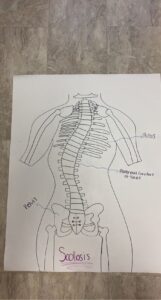
I did my project on scoliosis, my art project was a drawing of a body affected by socliosis and how ti curves the back and unevens the shoulders. My objective was know the bones and their part


I did my project on scoliosis, my art project was a drawing of a body affected by socliosis and how ti curves the back and unevens the shoulders. My objective was know the bones and their part
Jamie did her project on scoliosis. Her drawing demonstrates what happens as a result of developing scoliosis. The spine adapts an unnatural curvature that shifts the skeleton of the thoracic cavity to one side of the body. The curve is generally the most prominent at the bottom of the cervical spine and throughout the thoracic spinal column. Her main objective was knowing the bones of the spine and the role that they play. In her drawing, she clearly depicts the sections of the spine. At the top, she has the seven vertebrae for the cervical spine. Then she drew the twelve vertebrae of the thoracic spine and at the bottom is the five lumbar vertebrae. Each rib is drawn too. The spine wasn’t the only body part drawn out. Jamie included a view of the thoracic cavity and parts of the extremities to show the effect scoliosis has. One major bone influenced by scoliosis besides the spinal column, is the pelvic girdle. The curvature of the spine shifts the pelvis one way or another. This shift can cause difficulty walking or performing other functions that utilize the legs and therefore the pelvis as well. The shift caused from scoliosis affects the spine, pelvis, ribs, shoulders, and everything else in between that is part of their function. Jamie researched how the shoulders are made uneven from the spine curvature. My biggest takeaway form Jamie’s project is that scoliosis is a full-body restriction. The curve makes the shoulders uneven, effecting the rest of the body from the shoulders and above. The curve offsets the spine, offsetting the ribs and pelvis, which changes how the hips and legs function below.